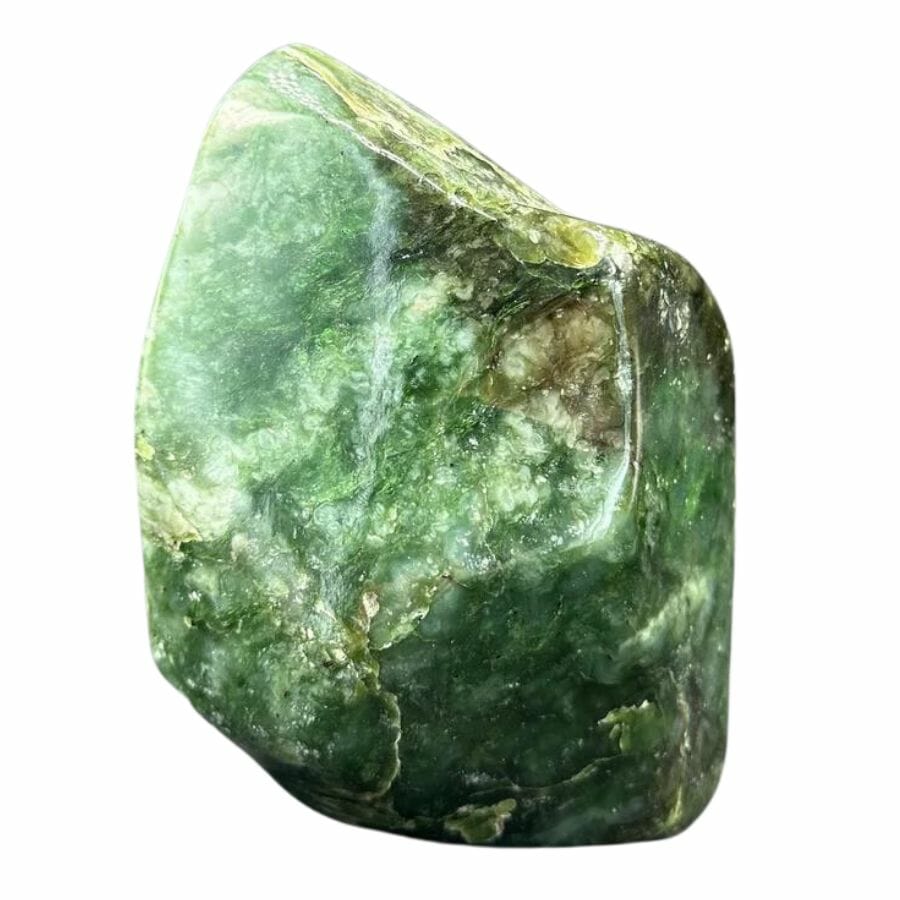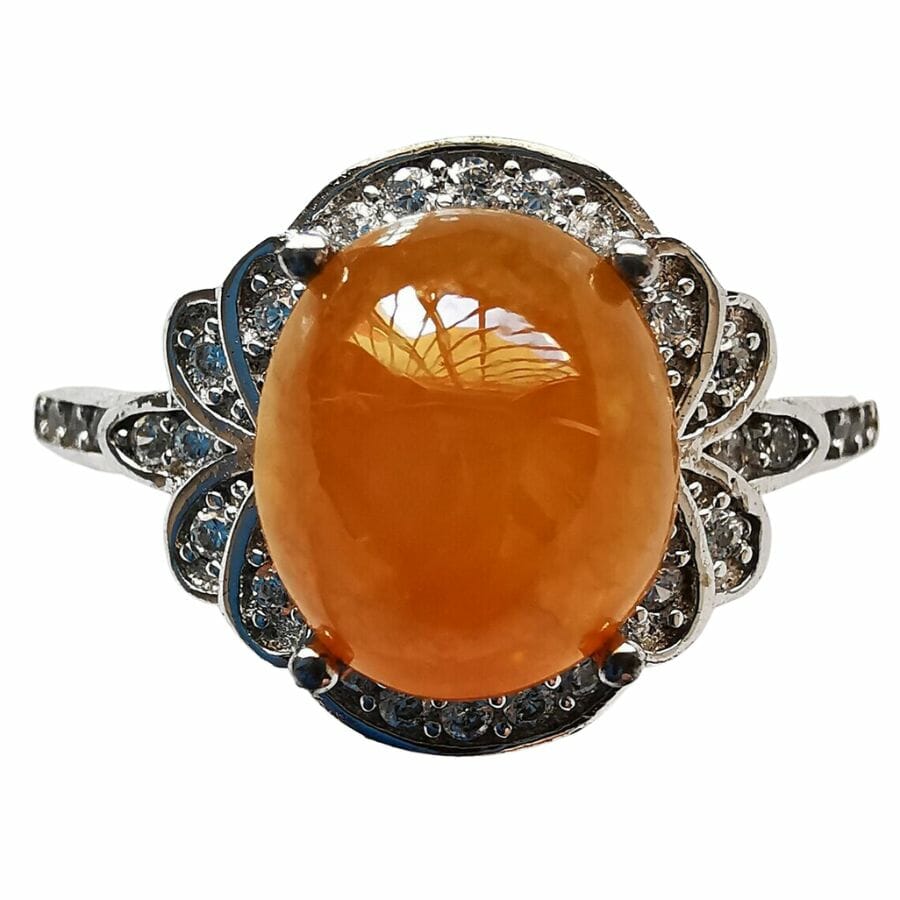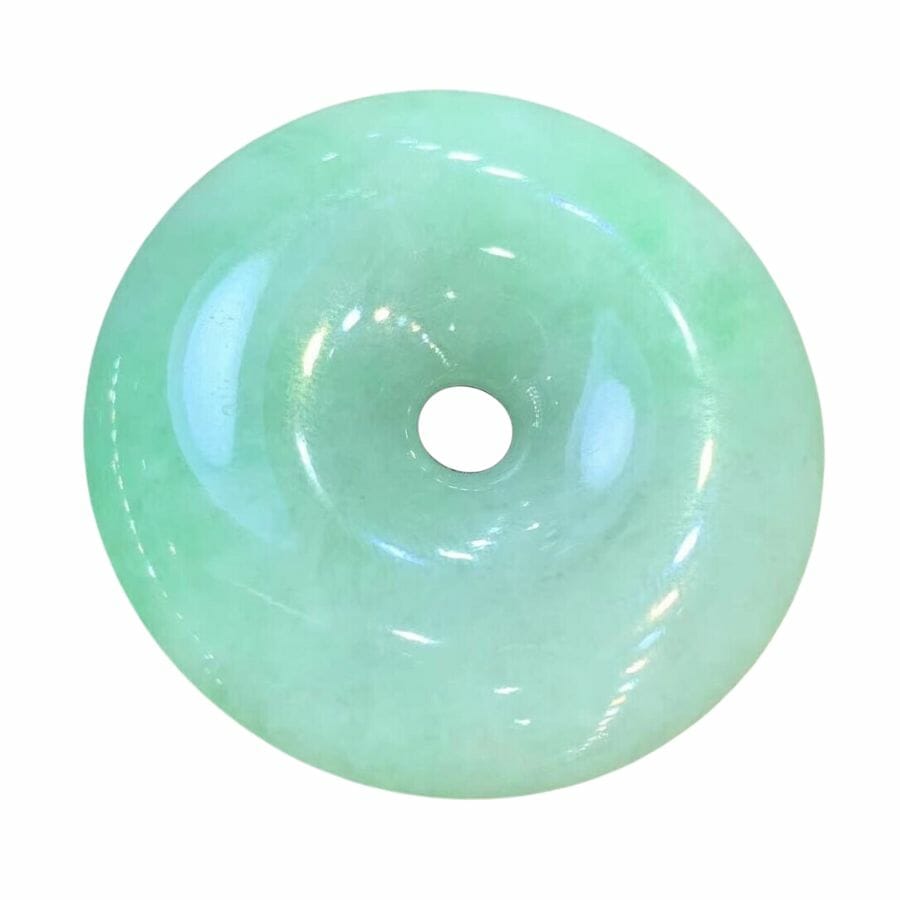Jade is a gem that has been treasured for centuries by cultures around the world. But not all jade is the same. When we talk about jade, we’re often referring to two different minerals: jadeite and nephrite.
The interesting thing is that it might be tricky to tell jadeite vs nephrite just by looking. But once you dive into the world of these two gems, you’ll find that they differ in color, texture, hardness, and even where they come from.
So, while they might look alike at first glance, there’s a whole world of unique traits that set them apart. As we delve deeper, you’ll get to know these two forms of jade and appreciate them for their individual qualities.
Jadeite vs Nephrite – The Major Differences
Jadeite and nephrite share some visual similarities and both have that classic jade feel. However, the differences between them run deep, from their physical properties to chemical compositions.
Appearance – Nephrite is often opaque

Some gemstones are clear, letting a lot of light pass through, just like a clean window. Others might be cloudy or completely solid, blocking the light.
There are three main terms we use: transparent (you can see right through), translucent (some light gets through, but it’s blurry), and opaque (no light passes through).
Jadeite is typically what we call translucent. That means light can pass through it, but you can’t clearly see objects on the other side.
Nephrite can be a little different. While it can also be translucent like jadeite, it’s also often opaque.
Colors – Jadeite comes in more colors

Jadeite and nephrite are both beautiful stones, but they show their beauty in different colors. Jadeite is like a colorful box of crayons. While many people think of it as green, jadeite comes in a lot of other shades.
Lavender jadeite looks like the soft purple of a spring flower, while yellow jadeite reminds you of a sunny day. Blue jadeite can be as deep as the ocean or as light as the sky. It also pops up in colors like black, red, and white.
Nephrite, on the other hand, is best known for its green colors. Imagine the leaves on trees or grassy fields. If you look around, you might find nephrite that’s brown like a chocolate bar, white like snow, or even gray like a rainy cloud.
Luster – Nephrite can look glassy or greasy

Luster is a cool word that describes how a gemstone shines when light hits it. Think of it like the glow or sparkle you see. Different gemstones have different types of luster, and it’s one of the ways we can tell them apart.
Jadeite has a luster that we call subvitreous. This means it has a kind of glow that’s a little less shiny than glass.
Furthermore, when you look at the parts of jadeite where it’s been split or broken, it can look pearly. That’s a soft, smooth shine, kind of like the inside of a seashell.
Nephrite’s luster can be vitreous, which means it shines like glass. But sometimes, nephrite can also have a greasy luster.
This doesn’t mean it feels like grease or oil. Instead, it’s a description of how it looks — a bit like how your skin might shine if you put lotion on it.
So, by looking at the luster, we can get hints about whether a piece of jade is jadeite or nephrite.
Hardness – Jadeite is somewhat tougher

Hardness describes how tough or scratch-resistant a mineral is. In the world of gemstones and rocks, we have a special tool called the Mohs hardness scale to measure this. The scale goes from 1 to 10.
A diamond, one of the hardest things on Earth, scores a perfect 10. Talc, which is super soft, gets a 1.
There’s a slight but noticeable difference in the hardness of jadeite and nephrite. Jadeite is pretty hard, scoring between 6.5 to 7 on the Mohs scale.
This means it’s tougher than some other common minerals and can resist getting scratched pretty well.
On the other hand, nephrite is a bit softer but still pretty tough. It scores between 6 to 6.5 on the scale. This means that while it’s a bit softer than jadeite, it’s still harder than many other stones out there.
Cleavage – Nephrite doesn’t break in clean planes

Another difference between jadeite and nephrite lies in how they break. Cleavage is the way a mineral breaks along flat surfaces. It’s kind of like how some chocolate bars are made with lines so you can break them into pieces easily.
Jadeite has what we call “good cleavage.” This means if you tried to break it, it would split along certain flat surfaces more easily. It’s got those chocolate bar lines that make it predictable where it might break.
On the other hand, nephrite has poor cleavage. This means if you tried to break it, it wouldn’t really have those flat, even splits. It would break in a more random way, without those clear lines.
Chemical composition – Jadeite is made of aluminum, silicon, and oxygen

Chemical composition sounds like a fancy term, but it’s just a way to talk about what stuff is made of. Every rock and mineral is like a recipe made up of different ingredients.
These ingredients are elements, and when they combine in specific ways, they create different minerals.
Take jadeite, for instance. It’s made of several elements: sodium (Na), aluminum (Al), silicon (Si), and oxygen (O). When these elements bond together, they create the mineral known as jadeite.
On the other hand, nephrite has its own mix of elements. It’s made of calcium (Ca), magnesium (Mg), iron (Fe), silicon (Si), oxygen (O), and hydrogen (H). These elements come together in a unique way to form nephrite.
Density – Nephrite can feel lighter for its size

Density is a way to measure how much matter is packed into a specific space. In simple words, it’s like checking how heavy something is for its size.
For example, a sponge might be big, but it’s light because it has low density. On the other hand, a small metal toy car can be surprisingly heavy for its size because it has high density.
There’s a noticeable difference in density when you compare nephrite vs jadeite. Jadeite is denser, with a range of about 3.24 to 3.43 g/cm³.
Meanwhile, nephrite’s density is around 2.95 g/cm³. If you have a piece of jadeite and a piece of nephrite that are the same size, the jadeite piece would feel heavier.
By comparing their densities, it’s clear that jadeite is a bit heavier for its size than nephrite. This difference can be one of the ways to tell these two types of jade apart.
Just remember, the bigger the density, the heavier the mineral is for its size.
Formation – Jadeite forms in high pressures but cool temperatures

Jadeite and nephrite are both types of jade, but they have different “birth stories.” It’s like how two people might live in the same town but come from different families.
Jadeite is formed deep inside the Earth, in places called subduction zones. This happens when one piece of the Earth’s crust sinks or “subducts” under another. Here, rocks are squished with a lot of pressure but aren’t super hot.
This unique mix of high pressure and cool temperature is the special recipe needed to make jadeite.
On the other hand, nephrite has its own formation story. It comes from the transformation of certain minerals called actinolite and tremolite. These minerals are part of a bigger family known as the amphibole group.
When these minerals experience a lot of pressure and heat deep inside the Earth, they change and become nephrite.
Now, if all this talk about how stones form gets you excited, consider going rock hunting near you. You never know what cool rocks you might find!
Fluorescence – Nephrite doesn’t glow under UV light

Fluorescence is a neat thing that some rocks and minerals can do. It’s like a secret glow they have when exposed to a special kind of light called UV light.
Imagine having a shirt that looks normal but glows in the dark when you turn off the lights. That’s kind of how fluorescence works for rocks and minerals.
When placed under UV light, jadeite might have a weak to moderate glow. This glow depends on the tiny bits or impurities inside it. So, not all jadeite will glow the same way; it depends on what it’s made up of.
Nephrite typically doesn’t show any fluorescence. Even under UV light, it keeps its cool and doesn’t shine back.
Price – Jadeite is the more expensive type of jade

Just like toys, games, or shoes, the price of rocks, minerals, and gemstones can vary a lot. The price of a rock is determined by a few things: how rare it is, its quality, and how much people want it.
For gemstones, things like color, clarity, and even where it’s from can make a difference in their price.
There’s a difference in the prices of jadeite and nephrite. Jadeite is usually more expensive. This is especially true if it’s top-quality, with a bright color and clearness. Imagine a clear blue sky; if jadeite looks pure like that, it can cost more.
On the other hand, nephrite usually costs less than jadeite. But that doesn’t mean all nephrite is cheap. Some high-quality nephrite, which looks really good and has no flaws, can have a high price too.
So, the value of jade can vary. Whether it’s jadeite or nephrite, the quality, color, and its desirability play a big part in its price.
Location – Nephrite can be found in the US

Jadeite and nephrite can be found in different places on our planet.
Jadeite can be found in Myanmar, Guatemala, and Japan. These countries have the right conditions in the ground to form jadeite.
On the flip side, nephrite has a more widespread family. It’s found in many countries, including China, Australia, Canada, and Russia.
Nephrite is also closer to home for some people than they might think. There are places in the US where nephrite is found, so there might even be a gem mine near you with some nephrite inside.
Nephrite vs Jadeite – The Similarities
Jadeite and nephrite have common traits that connect them as part of the jade family. Understanding what they have in common can help us appreciate the beauty of jade as a whole.
Crystal structure – Nephrite and jadeite have the same internal structure

Everything in nature has a pattern or arrangement, and rocks and minerals are no different. The way the tiny bits inside a mineral line up and connect is what we call its crystal structure.
Think of it like building with toy blocks. The way you arrange and stack the blocks can make different shapes and patterns.
Jadeite and nephrite both have a crystal structure that belongs to what scientists call the monoclinic system. Imagine it like a wonky box where two sides lean in a little, kind of like a slanted book on a shelf.
Streak – Both types of jade leave a white streak

Streak refers to the color that rocks and minerals leave behind when rubbed against a surface. To discover the color of the streak of rocks and minerals, people often use a special tool called a streak plate, which is an unglazed porcelain plate.
Both jadeite and nephrite have something in common when it comes to streak. When you rub them on the plate, they both leave a white mark. So, even though they might look different or come from different places, their streak is the same.
Magnetism – Neither stone can be attracted to a magnet

Magnetism is a force that can attract or push away certain things. You see it in action when magnets stick to your fridge. Some rocks and minerals can be attracted to magnets because they contain tiny bits of metal. But not all of them have this attribute.
Jadeite and nephrite are both generally non-magnetic. This means that if you took a strong magnet and held it close to these types of jade, they wouldn’t be attracted to the magnet.
Conductivity – Jadeite and nephrite don’t conduct energy

Conductivity tells us how well something can pass along energy. Think about how some things, like metal spoons, can get hot really quickly when you put them in a hot soup.
That’s because metal is a good conductor. It can easily pass along heat or electricity. On the other hand, materials like rubber or wood don’t let electricity flow through them easily, making them poor conductors.
Even though jadeite and nephrite are beautiful and can be shiny, they have something in common: they are both poor conductors of electricity.
That means if you tried to pass electricity through them, it wouldn’t work very well. They resist the flow of electricity instead of helping it move along.
The Easiest Ways to Tell Jadeite and Nephrite Apart
There are ways to distinguish jadeite vs nephrite. By looking closely and understanding their features, anyone can learn to spot the differences.
Look at the natural color of the stone

Jadeite can show up in a variety of colors. While green is popular, you might also find jadeite in lovely shades of lavender, bright blues, or even bold reds. So, if you see a piece of jade in a color like lavender or blue, it’s likely jadeite.
On the other hand, nephrite has a smaller color wardrobe. It’s most commonly seen in shades of green. But sometimes, nephrite can dress up in brown, white, or gray. It’s rare to see nephrite in the vibrant colors that jadeite can have.
So, by paying attention to the colors, you can get a good idea of whether you’re looking at jadeite or nephrite.
Evaluate how the surface of the stone feels

Jadeite and nephrite might look alike, but they have a different feel when you touch them. It’s like knowing the difference between a silk shirt and a cotton one just by feeling the fabric.
If you pick up a piece of jadeite, it has a feel similar to glass. It’s smooth and cool to the touch. Imagine running your fingers over a clean window or a drinking glass. That’s how jadeite typically feels.
When you touch nephrite, it doesn’t feel as glassy as jadeite. Instead, it has a kind of waxy or creamy feel. It’s like the difference between touching a candle and a piece of polished stone.
So, if you ever get a chance to feel a piece of jade, remember these hints. The way it feels can give away whether it’s jadeite or nephrite. It’s amazing how much our sense of touch can tell us!
Check out how well light passes through the stone

Imagine you have a piece of jade and you hold it up to a bright light, like a lamp or sunlight coming through a window.
If it’s jadeite, the stone might let some light shine through. This makes it look a little see-through, kind of like colored glass or a tinted window. The light might glow softly through the stone, showing its colors brightly.
On the other hand, nephrite acts differently. When you hold it up to light, it’s usually more like looking through a foggy window on a cold morning. It’s more cloudy and doesn’t let as much light pass through.
By using this simple light test, you can get a good hint about whether your jade piece is jadeite or nephrite. The way they play with light is quite different and can be a fun way to explore their beauty!


